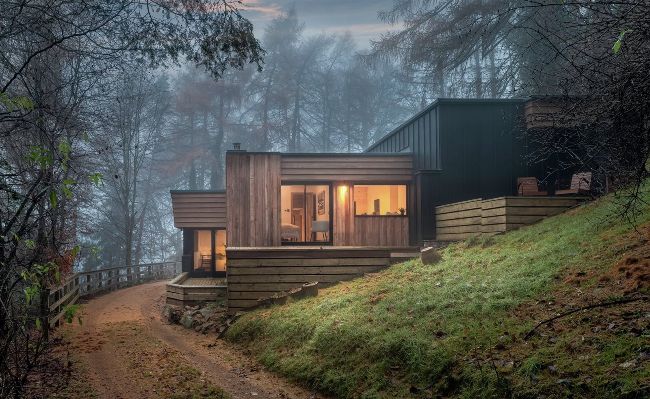MINIMALIST STYLE MAXIMUM POTENTIAL
Seamus and Lucy Shanks escaped the city to rescue a modernist home in Scotland – an architectural gem set against a stunning woodland backdrop

The home’s fairlytale setting won over the family at first sight.
WORDS
ALEXAN DRA PRATT PHOTOS
UNIQUEHOMESTAYS.COM Looking for somewhere to escape their busy London lives, Seamus and Lucy Shanks discovered their dream holiday home project in Melrose, Scotland. “When we saw this house, we immediately knew we could create something beautiful,” says Seamus, an architect with his own practice, Draw Architecture. The couple adored the seemingly magical setting: an acre of lush woodland that felt remote and secluded, yet was just a few minutes’ walk from Melrose –a town famous for its foodie vibe.
While the setting offered something majestic, it was actually the architecture of the home that instantly captivated Seamus. “The house was a very good example of Modernism,” he says. “However, the condition of the existing building meant that not many people would have recognised this.” Seamus and Lucy didn’t shy away from the challenge, and after securing the purchase of the home, embarked on improvements and restoration.
Hidden potential
Built sometime in the late 1950s, the once glamorous and cutting-edge home was now in a state of disrepair. Parts of the roof had collapsed, the windows were rotten and damp was pervasive. Inside, the house was cold and inefficient, while the internal finishes –including laminated walls –were not suitable. “The previous owners didn’t have the appetite for the work required,” says Seamus, who embraced the significant repairs. The original building was constructed from both masonry and timber frame, and the restoration works echoed that. One of the first tasks was fitting a new section of cavity wall and then applying new cladding across the entire building. Seamus used zinc and larch cladding for their weatherproofing properties and for how they complemented the home’s mid-century aesthetic perfectly. “The zinc was chosen for its longevity above anything else and we felt it contrasted the timber nicely,” says Seamus. Both materials act as a barrier, preserving the original building while requiring minimal ongoing maintenance, which was important to Seamus considering the home’s the rural setting. The cladding also had the added advantage of concealing some unsightly pinkish brickwork and sections of lime render that had deteriorated over the years since it had been applied.